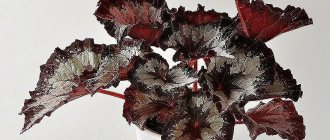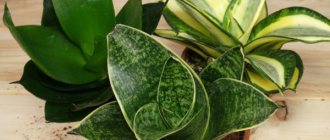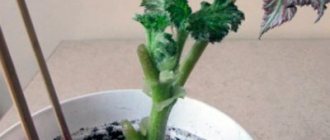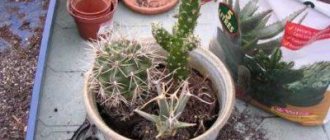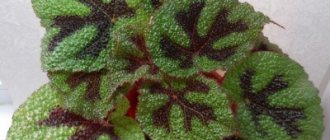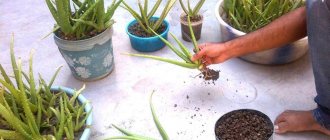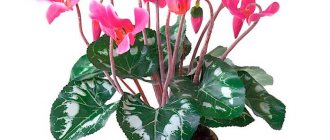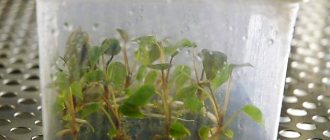Royal begonia, or Rex begonia, is deservedly one of the most popular decorative deciduous species. She received this royal name for her rich and sophisticated appearance.
The brightness of the leaves, the variety of their shapes and colors, compactness and relative ease of care make the plant an increasingly welcome guest in many homes and offices.
Popularly, royal begonia is sometimes called “elephant’s ear” due to the similarity of the shape of the leaves with the ears of this animal. Which plant variety to choose? How to properly care for and propagate it? What features are important to consider?
Description of the species and photos of varieties
The royal begonia is native to the tropical regions of Southeast Asia. It has a fleshy creeping rhizome that turns into a stem covered with bristles. The large leaves have pubescent long petioles and jagged edges, shaped like an asymmetrical heart.
The color of the leaf plate depends on the variety : silver, scarlet, purple, green, crimson inclusions, stripes, and blotches may be present. The veins on the leaves may vary in color. The flowers are small, pink, and have no decorative value.
Royal begonia forms a compact bush up to 40 cm high. Miniature varieties do not exceed 15 cm in height. Among the bright popular varieties are:
- Mary Christmas is a variegated variety, the leaf blade of which includes green, brown, crimson colors, mother-of-pearl inclusions and a burgundy border;
- Escargot - leaves are twisted in a spiral and look like a shell. A silver stripe runs down the center of the leaf;
- Griffin - large green-pink leaves have a pronounced carved edge;
- Dark Mambo has dark olive foliage and a light star in the center of each leaf blade.
Lighting
The brightly colored leaves of Rex Begonia require ample indirect light. However, direct scorching rays of the sun are contraindicated for it - burns may appear on the leaves, elasticity (turgor) will be lost, and the edges of the leaves will begin to dry out. The lack of light, in turn, will affect the color of the leaf plates: they will lose their brightness and become pale.
The optimal place for begonias will be eastern or western window sills with shading from the sun's rays.
It should be borne in mind that begonia does not like to be moved from place to place. It is also not recommended to rotate it around its axis. In winter, the flower can be placed on a south window.
Temperature
Since the royal begonia is native to tropical areas, it is quite thermophilic. However, it does not tolerate extreme heat and dry air.
In the summer months, the optimal temperature for it will be 20-25 degrees.
If the thermometer rises higher, be sure to provide the plant with high air humidity. In winter, it is recommended to reduce the temperature to 16-18 degrees, but not lower than 15. You can read more about keeping begonias in winter here. The flower should be placed away from heating appliances.
Such conditions can be created on an insulated balcony or loggia. It is important to ensure that the pot is not very close to the glass. Due to hypothermia of the root system, the plant may die.
During the warm season, the flower can be taken out into the fresh air, taking care to protect it from wind, precipitation and direct rays of the sun. Begonia Rex is very sensitive to drafts - it should be protected from them.
Propagation by tubers
It is used for tuber begonia species and is carried out in the spring when sprouts appear. The tuber is carefully cut into pieces with a knife, each with a fresh sprout. The cut areas must be powdered with wood ash, slightly dried, and then the nodules should be planted in prepared containers with substrate. You only need to fill it halfway, but when the sprouts reach a height of about 8-10 cm, you can fill the tubers completely.
As you can see, there is nothing here; the main thing is to carefully follow all the recommendations and observe temperature conditions when growing. But after a while, this amazing plant will thank you with lush, beautiful greenery and magnificent flowering.
Watering and air humidity
Royal begonia needs moderate and regular watering. Overdrying the earthen ball can lead to the leaves drying out, while overmoistening can cause the roots and stems to rot.
In summer, the plant needs more abundant watering than in winter. The next moistening should be done after the top layer of soil in the pot has dried.
For this purpose, settled or filtered water at room temperature is used. It is important to ensure that when watering, water does not fall on the leaves - this can cause them to rot.
Royal begonia needs high air humidity - about 60% . However, you cannot spray pubescent leaves - black spots may appear on them.
To achieve the optimal level of environmental humidity, you can use several methods:
- Humidify the air around the flower using a fine-grained spray bottle;
- Use a humidifier;
- Place the pot in a tray with damp expanded clay, pebbles, and sphagnum moss.
Begonia propagation tips
I decided to propagate this variety. Not everyone knows that royal begonia can be propagated both by cuttings, by cutting the stem at the internode above the two lower leaves and placing the cutting in water for rooting, and by leaves, by cutting or breaking them off along with the cuttings. In this case, the leaves are dipped by cuttings into a jar filled one-third with water and covered with a transparent plastic bag.
I cut the leaves on September 10th, and today is October 15th. It must be said that the room was cool, 17 ⁰C, and for successful rooting you need to create a temperature of 24-26 ⁰C, so instead of two or three weeks, the leaves took more than four to root. To date, not all leaf cuttings have survived this stress; some of them died, and this is natural. And some have released roots, and now they can be planted.
- Guzmania flower
How to properly care for begonia at home
Where to plant cuttings
To plant a cutting, you need a pot with a diameter of 10-12 cm and a light peat mixture with perlite. Planting rooted begonia leaves is very simple. The first step is to prepare 100-150 ml of warm water with a small amount of Kornevin for watering the planted leaf cuttings. The liquid should be cloudy.
Now add a layer of soil mixture about 3 cm thick into the pot so that the roots of the plant do not come into contact with the bottom of the pot. Take the cutting, straighten its roots, lower them into the pot and gradually add substrate to the container until it is filled to a height of 1.5-2 cm from the edge. After planting, lightly compact the soil around the cutting and water it with Kornevin’s solution. Excess liquid will pour out through the drainage holes, but if there is not enough moisture, this will complicate the rooting of the cutting.
This is how vegetative propagation of royal begonia is carried out using leaf cuttings.
Fertilizer
For good growth, bright and attractive leaves, royal begonia needs regular feeding, namely 3 times a month.
It is optimal to alternate mineral fertilizers with organic ones. They should be added after watering so as not to burn the roots.
Universal fertilizers for decorative foliage plants are used as mineral fertilizers.
At the same time, in spring and early summer it is recommended that the proportions of phosphorus, nitrogen and potassium in their composition be equal. From August, it is recommended to reduce the amount of the last two microelements by 2 times.
Manure (50 grams per 5 liters of water) or bird droppings (10 grams per 3 liters of water) can be used as organic fertilizers.
What soil is suitable for begonias?
Even if rooting was successful, transplanting begonias into soil with an irregular structure can lead to diseases and death of young plants. Roots obtained from leaves or cuttings are very weak, so they need light, breathable soil with sufficient mineral content. Flower shops sometimes sell specialized soil labeled “for begonias,” but it is not always ideal.
The correct substrate should consist of 2 parts of nutritious soil (chernozem, leaf humus), 1 part of coarse river sand or sphagnum moss and 1 part of loosening additives - perlite and vermiculite. These minerals can be added to the purchased mixture yourself, thereby improving its porosity.
7640.pf972c.840.jpg
Since begonia reacts very poorly to stagnant moisture, it is recommended to make the drainage layer in the pot not from expanded clay or other moisture-absorbing elements, but from pieces of polystyrene foam - through them, excess water will immediately flow into the pan, preventing rotting of the roots. Starting from 2-3 months of age, new seedlings can be fertilized with Potassium Monophosphate for abundant and long flowering.
razmnozhenie-begonii-deleniem-klubnya-foto-768×536.jpg
Watering the plants should be carried out so that the earthen ball does not have time to dry out completely, and it is advisable to spray the bushes themselves once a month with antibacterial drugs and growth stimulants to prevent diseases. With careful care, begonias will decorate your interior for many years with their colorful buds and lush tropical foliage.
Transfer
Rex begonia is transplanted once a year in the spring.
The pot needs to be 1.5-3 cm larger in diameter than the previous one. At the same time, it should be wide, but not deep, since the plant has a superficial root system. For replanting, purchased begonia substrate is used . If you have the desire and opportunity, you can prepare the earth mixture yourself. To do this, you need to take turf, leaf soil, peat and sand in equal proportions.
For better breathability, you can add vermiculite or turf humus to the soil. It is important to lay a good drainage layer at the bottom of the pot, consisting of expanded clay, broken bricks or clay shards.
The optimal method of transplantation is transshipment : this way the likelihood of damage to the root system is significantly reduced. During transplantation, it is important to ensure that the neck of the rhizome remains above the surface of the ground. Otherwise, the begonia may rot and die.
How to propagate royal begonia - 5 ways
There are several ways to propagate Rex begonia. Propagation by stem cuttings, seeds, pups and rhizomes has positive success among many gardeners.
Leaf
The most reliable and proven method is leaf propagation. This method can be used to propagate any type of begonia. A healthy and large leaf is divided into parts and planted in a moist substrate of peat and perlite. In order for leaf cuttings to take root successfully, they are planted on a slope. The plantings are covered with transparent film or glass, creating a greenhouse effect. If everything is done correctly, then within a month the leaves will take root. Two months after planting, the first leaves will appear on them.
Stem cuttings
To propagate this plant by stem cuttings, you need to cut shoots 10-15 cm long with 2-3 leaves. The lower leaves are removed, and the upper ones are shortened by a third of their length. After the cutting areas have dried, the cuttings are dipped in any growth stimulator - Kornevin or Heteroauxin for 30 minutes. The shoots are planted in a nutrient mixture of sand and soil for begonias. The cuttings are planted deep into the soil, right up to the leaves, covered with a transparent jar and placed in a warm place. Subsequent care of the plantings consists of periodic ventilation and spraying of the soil. This propagation makes it possible to obtain young plants within a month after planting.
Seed propagation
Propagation of begonias by seeds at home is a painstaking but successful process that is carried out in winter. This plant has very small seeds, so before sowing they are pelleted, mixed with sand. Seeds are planted superficially in a purchased begonia substrate. After this, the crops are moistened with a spray bottle and covered with transparent glass. To prevent the seedlings from becoming moldy, they are periodically ventilated. After 2-3 weeks, the emerging seedlings should be moved to a bright and cool place. In such conditions, the seedlings will not stretch.
As soon as the plants produce one pair of leaves, they are planted separately in disposable cups. You can remove miniature sprouts using a toothpick. The same soil is suitable for picking as for sowing seeds. To help young plants take root better, they can be sprayed with Zircon solution. At the stage of appearance of 5-6 leaves, plants are planted in permanent containers. Reproduction of begonias from seeds makes it possible to obtain beautiful plants that retain all the varietal characteristics and qualities of the mother bush.
Children
Reproduction of Rex begonia by children is carried out during transplantation. Young plants with roots are separated from the mother bush and planted in small pots with a nutrient substrate. Further care for them is the same as for adult specimens.
Propagation by dividing rhizomes
This method is carried out only for adult specimens who have reached the age of five.
The plant is removed from the planting container, the roots are washed under water, removing any remaining soil, and divided into parts. Each division must have at least one bud or shoot. The cut areas are sprinkled with coal powder and treated with Kornevin. The finished planting material is planted individually in wide containers, watered abundantly and placed in a bright and warm place.
Leaf propagation
For this propagation method, a large, healthy begonia leaf is divided into parts with a sharp knife so that each of them has a central vein.
Then they are planted in a mixture of sand and peat, taken in equal parts. They are either laid out on the surface and lightly sprinkled with substrate, or buried vertically with a lower cut of 1 cm.
The container with leaves is covered with polyethylene or glass. In 1-2 months you can expect the appearance of young specimens.
Only after this can you begin to ventilate the greenhouse, gradually accustoming the plants to room air.
Begonia leaf propagation technology
This method involves using fragments of a leaf plate with veins as planting material; young plants can be grown using this method in 1-2 months.
For propagation, one large leaf is selected; it must be completely healthy, free of any damage or fungal infections.
The sequence of planting begonias to obtain new shoots:
- The leaf blade is divided into several sectors, and it is important that each of them contains a fragment of the main vein, along which nutrients move.
- It is recommended to cut the sheet with a scalpel or other very sharp tool so that the edges of the cuts are neat.
- Each individual fragment is placed in a small container with substrate.
- The best option for replanting is a mixture of sand and peat in equal proportions; sometimes only sand is used.
- Leaf cuttings can be planted vertically so that the vein touches the substrate, but sometimes they are simply laid out on the surface.
- Each container with a leaf cutting must be placed in a mini-greenhouse.
- To do this, you can use a plastic container with a lid into which cups of substrate are placed, or you can simply cover each container with a cut-off plastic bottle.
- After about 15-20 days, the begonia will sprout.
- Until new leaves appear, the greenhouse must not be removed; the substrate must be kept slightly moist at all times.
- However, it should not be too wet, otherwise part of the leaf may rot.
When the leaf fragments take root, they must be removed from the greenhouse and transferred to the windowsill in a place with good lighting.
It is not recommended to remove the greenhouse immediately: the first ventilation should not last more than half an hour, gradually the plants need to be accustomed to being in the open air. Very soon the plantings will gain strength, and they can be moved to large pots or planted in open ground in a flower bed. Begonia is a fairly hardy flower; it will easily tolerate transplantation.
Rhizome division
This method is used for adult, strong specimens that have reached 4-5 years of age. To do this, the begonia is removed from the pot and the root system is washed with water.
Using a sharp knife, the rhizome is divided into parts so that each of them has at least one bud..
When begonia propagates, the cut sites are sprinkled with crushed charcoal.
The roots are treated with Heteroauxin or Kornevin. Each part is planted in an individual pot and watered.
Propagation of begonias by leaves
This method is also very common, and this is how I managed to get two beautiful types of this decorative foliage plant.
- To propagate, take a healthy leaf with a small petiole and place it in a glass of water. After some time, the leaf will give roots, and after that it can be transplanted into a pot with prepared soil.
- If you want to get several plants in a short time, then you need to use parts of one large begonia leaf. This method is suitable for those types of begonias that have pubescent leaves. For propagation, the leaf is carefully cut into several parts, and it is important that each fragment contains part of the main vein of the leaf.
Pieces of leaf are placed in separate containers with substrate, covered with plastic containers, creating a mini greenhouse. The soil must be constantly moistened, but not excessively saturated with water, so that the leaf cuttings do not rot. With this method, shoots appear within two weeks.
IMPORTANT! It is recommended to use a scalpel or a sharpened knife to cut the sheet, then the edges of the fragments will be smooth and neat.
Propagation by stem cuttings
Using a sharp knife, shoots from the end of the stem 8-12 cm long are cut. The lower leaves are removed, the remaining ones are cut in half. Then the cuttings are dried for 1-2 hours.
After this, the sections are treated with a root formation stimulator, for example, Kornevin or Heteroauxin, and planted in the ground to a depth of 1-2 cm.
A mixture of sand and begonia substrate in equal parts is used.
The container with sprouts is covered with glass or cellophane . Care after this consists of regularly ventilating the “greenhouse” and, if necessary, moistening the soil with a spray bottle.
After young leaves appear, the glass is removed.
Reproduction
There are three methods of propagation of this plant:
- leaf propagation;
- propagation by dividing the root system;
- propagation by stem cuttings.
Let's take a closer look at the above methods.
Leaf propagation
For propagation, a healthy and large begonia leaf is taken. It must be divided into several parts with a sharp knife so that each of them has a central vein.
After this, the resulting parts of the leaf plate must be planted in a substrate of sand and peat, taken in equal proportions. Pieces of leaves can be spread over the surface of the soil and lightly sprinkled or stuck into the soil with the bottom cut to a depth of 1 cm.
After this, the container with the leaves must be covered with plastic film or glass. After 1-2 months, young shoots will begin to appear.
Rhizome division
minimum
The roots must be treated with Heteroauxin or Kornevin. Each resulting part of the plant is planted in a separate pot and watered after planting.
Propagation by stem cuttings
The sections must be treated with a root formation stimulator. To do this, you can use “Kornevin” or “Heteroauxin”, after which the cuttings are planted in the soil to a depth of 1-2 cm. The soil should consist of equal parts of sand and substrate for begonias.
After planting, the pots are covered with glass or polyethylene. Care after planting should consist of regular ventilation, as well as moistening the soil with a spray bottle if necessary. Glass is removed from pots when young leaves appear.
Diseases and pests
The main reason for royal begonia to become infected with pests or diseases is improper or untimely care for it.
Among the pests that can pose a danger to the plant are thrips, scale insects and spider mites. It is important to regularly inspect the flower for their presence in order to detect the problem in a timely manner.
If uninvited guests appear, the infected specimen is removed away from healthy ones, the pests are removed mechanically, and the plant is treated with a soap solution.
If this method does not help or there are too many pests, you will have to use an insecticide: Nurell-D, Actellik, Fitoverm.
The most dangerous diseases for begonia are powdery mildew and root rot..
The first develops as a result of sudden changes in temperature and high air humidity and manifests itself in the appearance of a white coating on the leaves and stems.
Root rot develops due to overwatering. To combat diseases, the affected parts of the plant are removed, and the flower itself is treated with a fungicide: Fitosporin, Topaz, Skor.
Care problems
- Royal begonia leaves may develop brown spots due to sunburn. The plant should be removed from the scorching rays of the sun;
- Leaf edges may dry out as a result of low environmental humidity;
- Leaves lose their brightness and thin out when there is a lack of light. It is enough to place a pot with a flower in the light (diffused) - and the problem will be solved;
- Leaves begin to turn yellow as a result of lack of nutrients or insufficient watering. Regular fertilizing and well-established watering will solve the problem.
Royal begonia will be a chic decoration for any interior . A little effort and time - and she will thank you with the splendor of bright foliage!
